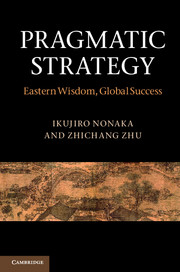1 - Introduction
Published online by Cambridge University Press: 05 June 2012
Summary
This is a strategy book. It is about how to strategise creatively, ethically,effectively. Our message is: we humans are pragmatic in our wise moments,and pragmatic strategy is apt for bettering firms, communities, society andMother Nature. If you want to walk in the world wisely, this book is foryou.
But why should we bother with another strategy book, one wonders, at a timewhen typing ‘strategic management’ and ‘businesspolicy’ pops up more than 76,000 results from Amazon and 3,380,000from Google Scholar? To answer this question, in this introductory chapterlet us have a brief look at how strategy has been doing, what is at stakeand what pragmatism means to strategy.
STRATEGY IN A CHANGING WORLD
Strategy is one of the oldest practices of humankind. Remember TheArt of War of Sunzi (孙子), the ancient Chinesegeneral? Yet as a systematic corporate undertaking, a scholarly i eld ofstudy and a multibillion- dollar consultancy industry, the search for modernstrategy did not emerge until the 1950s–1960s when Kenneth Andrews at theHarvard Business School delivered a course called BusinessPolicy, Igor Ansoff published his seminal bookCorporate Strategy in the US, Alfred Sloan illustratedthe M-form corporate structure in My Years with GeneralMotors and Alfred Chandler laid down the founding blocks ofStructure and Strategy , The Visible Hand andScale and Scope. That was the time of America’sundisputed industrial might, economic success and acclaimed businesseducation. For decades, all this served companies well. Subsequently, asMcDonaldisation spread around the world, so did strategy based on Western,or more precisely Anglo-Saxon, mindsets and experiences – the world wasflat.
Information
- Type
- Chapter
- Information
- Pragmatic StrategyEastern Wisdom, Global Success, pp. 3 - 23Publisher: Cambridge University PressPrint publication year: 2012
